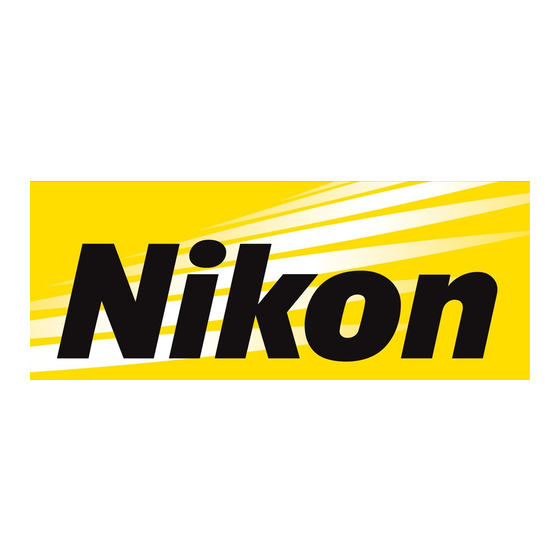
Advertisement
Quick Links
FEMA US&R Response Sys/U.S. Army Corps of Engineers
STRUCTURES SPECIALIST SKILLS TRAINING
TST – Total Station Training
Session 1-1
Session 1-2
Session 1-3
Session 1-4
Session 2-1
Session 2-2
Session 2-3
TOTAL STATION USE
FOR THE
STRUCTURAL SPECIALIST
October 13, 2007
Basics of the NPL-352 and Theodolite Use
Classroom - 45 minutes
Basic Field Set-up and Theodolite Use
Field - 60 minutes
Initial Configuration and Basic EDM Use
Classroom - 60 minutes
Basic Field Use of the EDM
Field - 60 minutes
Advanced Use of Total Station
Classroom - 30 minutes
Advanced Use of Total Station
Field - 120 minutes
Use of Total Station for US&R
Classroom - 30 minutes
Measurement Basics and Theodolite Use Page 1
October 2007
Advertisement

Summary of Contents for Nikon NPL-352
- Page 1 TST – Total Station Training TOTAL STATION USE FOR THE STRUCTURAL SPECIALIST October 13, 2007 Session 1-1 Basics of the NPL-352 and Theodolite Use Classroom - 45 minutes Session 1-2 Basic Field Set-up and Theodolite Use Field - 60 minutes Session 1-3...
- Page 2 FEMA US&R Response Sys/U.S. Army Corps of Engineers STRUCTURES SPECIALIST SKILLS TRAINING October 2007 TST – Total Station Training Session 1-1 Measurement Basics and Theodolite Use Basic Measurement Tools Theodolite vs. Total Station 1) Theodolites measure horizontal and vertical angles. 2) Total Stations combine theodolites with the ability to measure distance.
- Page 3 FEMA US&R Response Sys/U.S. Army Corps of Engineers STRUCTURES SPECIALIST SKILLS TRAINING October 2007 TST – Total Station Training Distance Measurement Prism Prism Instrument Constant Constant (PC) PT- B PT- A HI = the height of the instrument (vertical distance from station point at Point A to axis of telescope).
- Page 4 FEMA US&R Response Sys/U.S. Army Corps of Engineers STRUCTURES SPECIALIST SKILLS TRAINING October 2007 TST – Total Station Training Location Measurement In 3 Dimensions The conventional survey coordinate order is N E Z and the total station normally outputs coordinates as N, E, Z: N is Northing (0 on the azimuth) •...
- Page 5 FEMA US&R Response Sys/U.S. Army Corps of Engineers STRUCTURES SPECIALIST SKILLS TRAINING October 2007 TST – Total Station Training Location Measurement In US&R Y (N) MP (x,y,z) CP (x,y,z) X (E) IP (x,y,z) MP = Monitoring Point IP = Instrument Point CP = Control Point Current thinking for US&R is to set the X axis parallel to the side of the building facing the instrument and the Y axis perpendicular to the building.
- Page 6 A prism is not necessary, however, this technology has limited distance capability (about 300 feet). Tools Contained in the Case 1) Nikon NPL-352 2) Mini Prism, Pole, and Tips 3) Batteries and Charger 4) Power Inverter 5) Shoulder Straps...
- Page 7 FEMA US&R Response Sys/U.S. Army Corps of Engineers STRUCTURES SPECIALIST SKILLS TRAINING October 2007 TST – Total Station Training The 2 Faces of the Nikon NPL-352 1) Face 1 of the instrument is the face with the tangent screws. Sighting Pointer...
- Page 8 Certain keys have additional functions when pressed and held for one second or more. Nikon refers to these as 1 - Second Keys. The MSR, DAT, DSP, USR and S-O keys are all 1-Second Keys. We will address the alternate functions of the keys in a later section of this class.
- Page 9 Marking one of the batteries that comes with the NPL-352 as the "A" battery and the other as the "B" battery makes it easier to track that the batteries are being cycled through the charger on a regular basis.
- Page 10 Use of Total Station as Theodolite Theodolites are still valuable for monitoring structures. Total stations can be used as simple theodolites. This section shows how to start up the NPL-352 and use it as a theodolite. After leveling the instrument with the bull's-eye level, turn on the instrument.
- Page 11 There are four BMS screens which are viewed in order by pressing the DSP key repeatedly. When the NPL-352 is used as a theodolite, only the first screen is needed. After leveling the instrument with the bull's-eye level, turning it on, and before tilting the telescope, the instrument may need to be fine leveled using the electronic angle compensators.
- Page 12 It should be noted that the accuracy of a 5 second theodolite or total station is approximately 1/8" for a point 400 feet distant. Although the NPL-352 is rated as a 5 second machine, its performance is always better than this. This level of accuracy should be more than sufficient for the purposes of monitoring points in the US&R environment.
















Need help?
Do you have a question about the NPL-352 and is the answer not in the manual?
Questions and answers